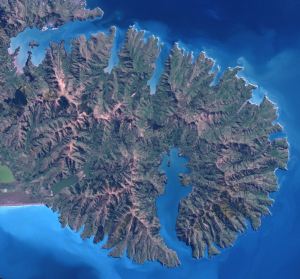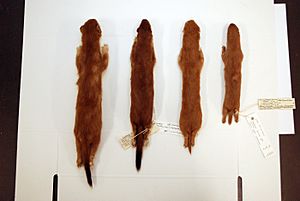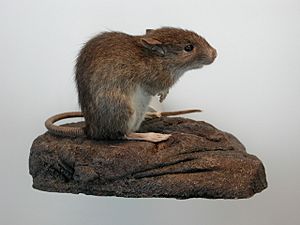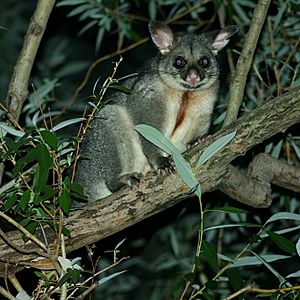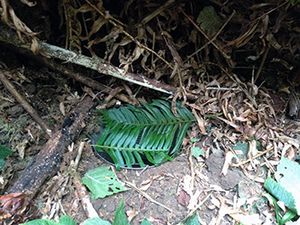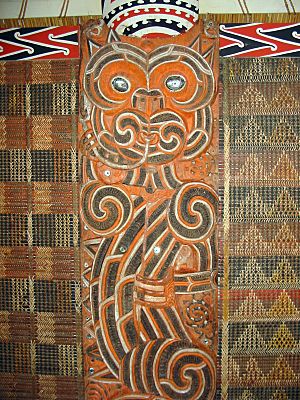Canterbury gecko facts for kids
Quick facts for kids Canterbury gecko |
|
|---|---|
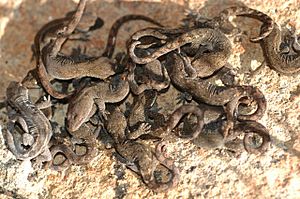 |
|
| Baby Canterbury (or Waitaha) geckos | |
| Scientific classification | |
| Genus: |
Woodworthia
|
| Species: |
brunnea
|
| Synonyms | |
|
|
The Canterbury gecko (Woodworthia brunnea) is a special type of gecko found only in the South Island of New Zealand. People also call it the Waitaha gecko or Moko-pāpā in Māori. It's sometimes known as the Brown gecko too. These geckos used to be in a different group called Hoplodactylus brunneus. But after more research, scientists split that group into six new genera, and the Canterbury gecko got its own new group called Woodworthia.
Woodworthia geckos are part of a very old group of lizards called Diplodactylidae. This group is only found in Australia, New Caledonia, and New Zealand. The big differences between the geckos in New Zealand and Australia suggest that geckos have been in New Zealand for a very long time. They might have been here since New Zealand broke away from the huge Gondwana supercontinent about 85 million years ago. Canterbury geckos are usually brown with cool patterns, like stripes. Their eyes can be green, brown, or bright yellow. You can find them in many places, like sand dunes, forests, and rocky areas. This gecko is endemic to New Zealand, meaning it lives nowhere else in the world.
Contents
What Does the Canterbury Gecko Look Like?
Geckos are special lizards with big eyes that are always open. They have long, fleshy tongues that they use to clean their eyes and mouths. Their toes have tiny hair-like structures called setae. These help them stick to smooth surfaces, almost like a magnet. Woodworthia geckos are often darker than other New Zealand gecko species. Woodworthia brunnea geckos are usually brown, grey, or olive. They have pale bands, blotches, or stripes that stand out. They also have large dark patches, often on their tails.
Their eye color can be green, brown, or bright yellow. They usually have a thin or wide pale stripe running from their eye to their nose. The scale above their mouth (called the rostral scale) touches or almost touches their nostril. Their bellies are usually pale and plain, but some have spots. They have pink mouths with a pink tongue that has a grey tip. Geckos from sandy dune areas are smaller than those from forests or rocky places. They measure about 53–68mm from snout to vent (the opening at the end of their body). Forest geckos are 53–80mm long. Their tail is usually about the same length as their body. Canterbury geckos have 9-12 special scales called lamellae on their toes. Their feet are usually light grey. Their colors and patterns can change a lot, which made them hard to classify as their own species in the past.
Where Do Canterbury Geckos Live?
The Woodworthia brunnea gecko is an endemic species. This means it lives naturally only in the South Island of New Zealand. The New Zealand Department of Conservation lists them as "Indigenous (Endemic)". They are also classified as a declining species in New Zealand.
You can find these geckos in the South Island, from southern Marlborough down to mid-Canterbury and the Banks Peninsula. They also live inland on the Canterbury Plains and on coastal hills south of the Rakaia River. Smaller ones have been seen on Kaitorete Spit. They are common around the Banks Peninsula and the Port Hills. However, they have disappeared from many parts of the Canterbury Plains. This is due to habitat loss and changes in how the land is used.
Canterbury geckos like many different lowland habitats. They live in trees in forests, hiding under loose bark or in deep holes, especially in dead trees. They also live in rocky areas with cracks, rock piles, and cliffs with bushes. In sand dunes, they hide among driftwood, bushes, rocks, and a plant called pohuehue. They are also found along coastlines, especially at Birdling's Flat and Kaitorete Spit.
The Banks Peninsula gets about 969mm of rain each year. Geckos prefer the drier East Coast of New Zealand. Temperatures range from 4 to 23 degrees Celsius in summer and 2 to 13 degrees Celsius in winter. Canterbury gets about 2100–2300 hours of sunshine every year. Canterbury geckos tend to stay in one small area. They have also learned to live in changed habitats, like shelterbelts and wild areas on farms.
Woodworthia brunnea geckos are adaptable. They live in coastal, lowland, and mountain areas of the South Island. They are usually found below the tree line. On islands without predators, they sometimes live in seabird burrows. They can also be found in places changed by humans, like near buildings. Small-leaved coprosmas are a favorite plant for New Zealand lizards. Their tangled branches offer good protection. Pohuehue (Muehlenbeckia complexa) is another favorite. It has many insects for food, and its fruit is perfect for lizards.
Life Cycle and Reproduction
Female geckos in New Zealand usually mate in autumn. They store the sperm over winter and then get pregnant in the spring. Their pregnancy usually lasts about three months. However, it can sometimes be as long as 14 months. This is because the length of pregnancy depends on the temperature. This is especially true for geckos like Woodworthia brunnea, which look for food at night.
New Zealand geckos (and skinks) become old enough to reproduce around three years of age. This can vary depending on the species and their health. Their size seems to be the main factor for mating. Some geckos in captivity have mated and had babies at two years old. However, their first birth is often just one baby, not the usual two.
Woodworthia brunnea geckos are mostly active at night. But they sometimes bask in the sun at the entrance to their hiding spots. They often gather in large groups, especially in places without predators. The Woodworthia brunnea is known to live the longest of any New Zealand gecko species. One lived for 53 years in the wild! Young geckos are born in late February to March. Females usually give birth to a maximum of two babies. They are viviparous. This means the eggs hatch inside the mother's body before the young are born. Scientists think this is an adaptation to New Zealand's cooling climate during the ice ages. Most other viviparous lizards live in colder parts of the world.
They usually mate once a year, in spring or summer. Geckos are very sensitive to temperature. In cooler climates, their reproductive cycle can be longer. Females might have babies every second or third year instead of every year. They control their body temperature by basking in the sun. Many New Zealand geckos can change their color to absorb more heat energy.
What Do Canterbury Geckos Eat?
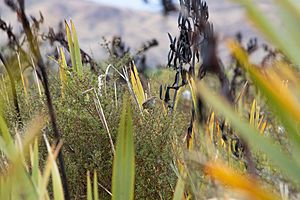
Canterbury geckos are omnivores. This means they eat both plants and animals. They mainly eat small invertebrates like moths and flies. They also enjoy fruit, especially from Coprosma plants, and some nectar from flowers.
Most New Zealand native lizards are omnivores. They eat various insects, sometimes other lizards, berries, or even nectar and pollen from flowers. Woodworthia brunnea geckos mainly eat insects, but they also eat fruit (berries). New Zealand geckos are known to drink nectar from many native plants. These include cabbage trees, flax, southern rātā, and pōhutukawa. They likely help pollinate these plants a little too. Plants like mingimingi (Coprosma propinqua) produce small black or blue berries. These are a favorite food for lizards. Studies suggest that New Zealand lizards are good at spreading seeds. They eat fruits from about 23 native species. They prefer white-blue fruits, even though these are less common. White-blue fruits are often found in open areas, which can be near the rocky homes of Woodworthia brunnea. It was also found that seeds that pass through lizards can still grow well. Lizards usually spread seeds less than 20 meters. But they help seeds get away from the parent plant and find good places to grow. In areas without fruit-eating birds, lizards might be the only animals left to spread seeds.
Lizards change their behavior based on the weather or where they are. When it's cold, they might stay still or wait for food to come to them. In warmer weather, they might move around more to find food.
Who Are the Gecko's Predators?
Canterbury geckos in the wild sometimes have small red mites. All New Zealand geckos face two main dangers: being eaten by predators and losing their homes. The main predators of the Canterbury gecko are mammals that were brought to New Zealand. These include mice, rats, weasels, hedgehogs, cats, stoats, ferrets, pigs, and possums. As towns grow in Canterbury, geckos are being pushed out of their natural homes. Burning and ploughing land also threaten geckos that live in rocky areas.
Mammals brought to New Zealand are a huge threat to many native species, including Woodworthia brunnea. Before humans arrived, birds and lizards were the main land animals in New Zealand. Because there were no large predatory mammals, many native species were not afraid of them. Native lizards are now hunted by cats, mustelids (like stoats), possums, hedgehogs, and rats. Some lizards on the mainland and smaller islands disappeared after rats were introduced. Many more disappeared after European predators arrived. The Department of Conservation estimates that New Zealand's 1.4 million pet cats kill over 18 million animals a year, including over 1 million native birds.
Three species of New Zealand lizards have become extinct since humans arrived. Another eight only survive on faraway islands where there are fewer predators. Geckos that are active at night, like Woodworthia, are more at risk. This is because many mammal predators hunt at night. Many lizards now live in small, separate groups because of habitat loss and predators. Almost half of New Zealand's reptile species are listed as threatened or endangered. It is illegal to handle or keep any native lizard without a permit from DOC.
Geckos do have a way to defend themselves. They can drop their tails if a predator grabs them. The tail keeps wiggling and distracts the predator while the gecko escapes. It takes a few years for the tail to grow back, so they can't do this every time. Larger reptiles and amphibians sometimes eat smaller geckos. Big insects like centipedes and spiders can also be predators. Birds like owls, terns, and kingfishers will eat geckos, as will blackbirds and magpies. Introduced insects like ants, wasps, and mantids have also been known to eat some New Zealand lizards.
Mites are common parasites on all lizard species in New Zealand. They look like tiny red, orange, or white spots around the eyes, ears, armpits, and legs. Lizards can also have internal parasites like nematodes and diseases like Salmonella. Skrjabinodon poicilandri is a native nematode that only infects geckos. Geckos get infected when they accidentally eat the nematode eggs.
New Zealand Lizard History
New Zealand has 99 different types of native lizards. All of them belong to groups found only in New Zealand. They are also special because they have adapted very well to living in cold climates. Most New Zealand lizards give birth to live young. This is unusual because most lizards around the world lay eggs. This adaptation helps the mother gecko choose the best temperature for her babies. She can bask in the sun or move into a deep, warm hiding spot. These lizards also live for a very long time, often 40 years or more. This long life comes from living "in slow motion" in cool temperatures. In snowy mountain areas, they also hibernate for a long time.
In comparison, many lizard species in other parts of the world only live 5–10 years. This long lifespan also means their pregnancies and growth rates are much longer. New Zealand's lizards live in many tough environments. These include snowy alpine areas and coastal areas hit by waves. Scientists think New Zealand lizard species have been here for at least 40 million years. Older species like the tuatara and amphibians have been here for about 80 million years.
Other Interesting Facts
Geckos can make sounds. Many New Zealand species make a chirping sound. Some green geckos make a sound like a 'bark'. You can find them on both the main islands and smaller islands. They live at many different heights, from sea level up to about 2200 meters. They also live in many different habitats.
Scientists often find and monitor lizards using special traps called pitfall traps. But Tony Whitaker (in 1967) found geckos that are active at night, like Woodworthia brunnea, by looking for their 'eye-shine'. This is a glow created when light from a torch reflects off a special layer in their eye. He developed a special spotlight attached to binoculars. This helped him find geckos from 10–100 meters away. This equipment was very helpful for searching difficult areas or places where there weren't many geckos. Tracking tunnels are another way to monitor them. These tunnels collect footprints, which can help tell different gecko species apart.
In 2015, some Woodworthia brunnea geckos were moved to Riccarton Bush. They came from the cliffs above Rāpaki. Their home was in danger because of work planned after the 2011 Christchurch earthquake. Two hundred and nine geckos were rescued by rope experts. The new forest home in Riccarton Bush was different from their rocky cliff home. But it was chosen because it has a predator-proof fence around it. This gave the geckos the best chance to survive. Canterbury geckos used to live in Riccarton Bush until the 1980s, so scientists knew they could live there again. The geckos were fitted with tiny radio transmitters. They were released into kahikatea trees. Most moved to other vine-covered trees or stumps. One even moved into a cabbage tree. The transmitters helped scientists track how far the geckos moved and if they stayed close enough to mate. The geckos seem to have settled in well.
Māori people brought their traditional names for reptiles and amphibians with them. Ngārara is the general term for reptiles. Moko or mokomoko means lizards. Other names like moko pāpā refer to specific types of reptiles. Reptiles are very important in Māori culture and spirituality. They appear in many myths and legends. They are linked to death, demons, and the afterlife. There can be a lot of cultural superstition and fear around ngārara. Green geckos are sometimes seen as a bad omen. Some iwi (tribes) see lizards as kaitiaki (guardians) of the dead. Lizards were often buried or placed near important buildings. In art like carvings, petroglyphs, tattoos, and pendants, reptiles are often shown. But strangely, native frogs are not shown and don't appear in myths, even though Māori would have seen them.
Images for kids


